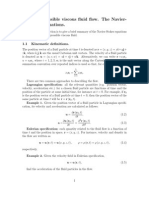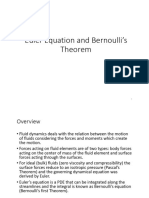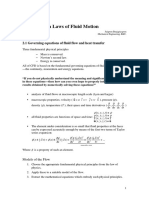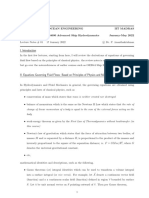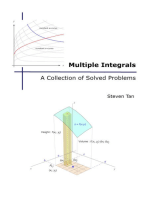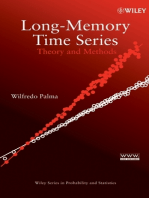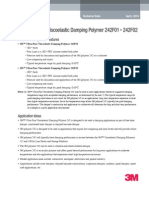1.7 Stress Tensor
Uploaded by
Astrini Nurul Sentanu1.7 Stress Tensor
Uploaded by
Astrini Nurul Sentanu2.
20 Marine Hydrodynamics, Fall 2011
Lecture 3
Copyright c 2011 MIT - Department of Ocean Engineering, All rights reserved.
2.20 Marine Hydrodynamics
Lecture 3
1.7 Stress Tensor
1.7.1 Stress Tensor
ij
The stress (force per unit area) at a point in a uid needs nine components to be completely
specied, since each component of the stress must be dened not only by the direction in
which it acts but also the orientation of the surface upon which it is acting.
The rst index i species the direction in which the stress component acts, and the second
index j identies the orientation of the surface upon which it is acting. Therefore, the i
th
component of the force acting on a surface whose outward normal points in the j
th
direction
is
ij
.
X
1
X
2
X
3
31
11
21
22
12
32
13
23
33
Figure 1: Shear stresses on an innitesimal cube whose surfaces are parallel to the coordinate
system.
1
Figure 2: Innitesimal body with surface PQR that is not perpendicular to any of the Cartesian
axis.
Consider an innitesimal body at rest with a surface PQR that is not perpendicular to any
of the Cartesian axis. The unit normal vector to the surface PQR is n = n
1
x
1
+n
2
x
2
+n
3
x
3
.
The area of the surface = A
0
, and the area of each surface perpendicular to X
i
is A
i
= A
0
n
i
,
for i = 1, 2, 3.
Newtons law:
on all 4 faces
F
i
= (volume force)
i
for i = 1, 2, 3
Note: If is the typical dimension of the body : surface forces
2
: volume forces
3
An example of surface forces is the shear force and an example of volumetric forces is the
gravity force. At equilibrium, the surface forces and volumetric forces are in balance. As
the body gets smaller, the mass of the body goes to zero, which makes the volumetric
forces equal to zero and leaving the sum of the surface forces equal zero. So, as
0,
all4faces
F
i
= 0 for i = 1, 2, 3 and
i
A
0
=
i1
A
1
+
i2
A
2
+
i3
A
3
=
ij
A
j
. But the area
of each surface to X
i
is A
i
= A
0
n
i
. Therefore
i
A
0
=
ij
A
j
=
ij
(A
0
n
j
), where
ij
A
j
is
the
notation (represents the sum of all components). Thus
i
=
ij
n
j
for i = 1, 2, 3,
where
i
is the component of stress in the i
th
direction on a surface with a normal n . We
call
i
the stress vector and we call
ij
the stress matrix or tensor.
2
1.7.2 Example: Pascals Law for Hydrostatics
In a static uid, the stress vector cannot be dierent for dierent directions of the surface
normal since there is no preferred direction in the uid. Therefore, at any point in the
uid, the stress vector must have the same direction as the normal vector n and the same
magnitude for all directions of n .
Pascals Law for hydrostatics:
ij
=
no summation
..
(p
i
) (
ij
)
=
_
_
p
1
0 0
0 p
2
0
0 0 p
3
_
_
where p
i
is the pressure acting perpendicular to the i
th
surface. If p
0
is the pressure acting
perpendicular to the surface PQR, then
i
= n
i
p
0
, but:
i
=
ij
n
j
= (p
i
)
ij
n
j
= (p
i
)(n
i
)
Therefore p
o
= p
i
, i = 1, 2, 3 and n is arbitrary.
3
1.7.3 Symmetry of the Stress Tensor
To prove the symmetry of the stress tensor we follow the steps:
j
o
i
ji
ij
ji
ij
Figure 3: Material element under tangential stress.
1. The
of surface forces = body forces + mass acceleration. Assume no symmetry.
Balance of the forces in the i
th
direction gives:
()(
ij
)
TOP
()(
ij
)
BOTTOM
= O(
2
),
since surface forces are
2
, where the O(
2
) terms include the body forces per unit
depth. Then, as 0, (
ij
)
TOP
= (
ij
)
BOTTOM
.
2. The
of surface torque = body moment + angular acceleration. Assume no sym-
metry. Balance of moments about o gives:
(
ji
) (
ij
) = O(
3
),
since the body moment is proportional to
3
. As 0 ,
ij
=
ji
.
4
1.8 Mass and Momentum Conservation
Consider a material volume
m
and recall that a material volume is a xed mass of mate-
rial. A material volume always encloses the same uid particles despite a change in size,
position, volume or surface area over time.
1.8.1 Mass Conservation
The mass inside the material volume is:
M(
m
) =
___
m(t)
d
S
m
(t)
) t (
m
Figure 4: Material volume
m
(t) with surface S
m
(t).
Therefore the time rate of increase of mass inside the material volume is:
d
dt
M(
m
) =
d
dt
___
m
(t)
d = 0,
which is the integral form of mass conservation for the material volume
m
.
5
1.8.2 Momentum Conservation
The uid velocity inside the material volume in the i
th
direction is denoted as u
i
. Linear
momentum of the material volume in the i
th
direction is
___
m(t)
u
i
d
Newtons law of motion: The time rate of change of momentum of the uid in the material
control volume must equal the sum of all the forces acting on the uid in that volume.
Thus:
d
dt
(momentum)
i
=(body force)
i
+ (surface force)
i
d
dt
___
m(t)
u
i
d =
___
m(t)
F
i
d +
__
Sm(t)
ij
n
j
..
i
dS
Divergence Theorems For vectors:
___
v
. .
v
j
x
j
d =
__
S
v. n
..
v
j
n
j
dS
For tensors:
___
ij
x
j
d =
__
S
ij
n
j
dS
Using the divergence theorems we obtain
d
dt
___
m(t)
u
i
d =
___
m(t)
_
F
i
+
ij
x
j
_
d
which is the integral form of momentum conservation for the material volume
m
.
6
1.8.3 Kinematic Transport Theorems
Consider a ow through some moving control volume (t) during a small time interval t.
Let f (x, t) be any (Eulerian) uid property per unit volume of uid (e.g. mass, momentum,
etc.). Consider the integral I(t):
I(t) =
___
(t)
f (x, t) d
According to the denition of the derivative, we can write
d
dt
I(t) = lim
t0
I(t + t) I(t)
t
= lim
t0
1
t
_
_
___
(t+t)
f(x, t + t)d
___
(t)
f(x, t)d
_
S(t)
S(t+t)
) t t ( +
) t (
Figure 5: Control volume and its bounding surface S at instants t and t + t.
7
Next, we consider the steps
1. Taylor series expansion of f(x, t + t) about (x, t).
f(x, t + t) = f(x, t) + t
f
t
(x, t) + O((t)
2
)
2.
___
(t+t)
d =
___
(t)
d +
___
d
where,
___
d =
__
S(t)
[U
n
(x, t)t] dS and U
n
(x, t) is the normal velocity of S(t).
S(t)
dS
2
n
) t ( O t ) t , x ( U +
v
S(t+t)
Figure 6: Element of the surface S at instants t and t + t.
Putting everything together:
d
dt
I(t) = lim
t0
1
t
_
_
___
(t)
df + t
___
(t)
d
f
t
+ t
__
S(t)
dSU
n
f
___
(t)
df + O(t)
2
_
_
(1)
8
From Equation (1) we obtain the Kinematic Transport Theorem (KTT), which is equivalent
to Leibnitz rule in 3D.
d
dt
___
(t)
f(x, t)d =
___
(t)
f(x, t)
t
d +
__
S(t)
f(x, t)U
n
(x, t)dS
For the special case that the control volume is a material volume it is (t) =
m
(t) and U
n
= v n, where v is the uid particle velocity. The Kinematic Transport Theorem (KTT),
then takes the form
d
dt
___
m(t)
f(x, t)d =
___
m(t)
f(x, t)
t
d +
__
Sm(t)
f(x, t)(v n)
. .
f(v
i
n
i
)
(Einstein Notation)
dS
Using the divergence theorem,
___
. .
x
i
i
d =
__
S
n
..
i
n
i
dS
we obtain the 1
st
Kinematic Transport Theorem (KTT)
d
dt
___
m(t)
f (x, t) d =
___
m(t)
_
f(x, t)
t
+ (fv)
. .
x
i
(fv
i
)
_
d,
where f is some uid property per unit volume.
9
1.8.4 Continuity Equation for Incompressible Flow
Dierential form of conservation of mass for all uids Let the uid property
per unit volume that appears in the 1
st
KTT be mass per unit volume ( f = ):
0 =
conservation
of mass
d
dt
___
m(t)
d =
1
st
KTT
___
m(t)
_
t
+ (v)
_
d
But since
m
is arbitrary the integrand must be 0 everywhere. (Because if it is not
zero at any point then we can shrink the volume to that point and get a non-zero
result which is a contradiction)
Therefore:
t
+ (v) = 0
t
+ [v
. .
D
Dt
+ v] = 0
Leading to the dierential form of
Conservation of Mass:
D
Dt
+ v = 0
10
Continuity equation Conservation of mass for incompressible ow In
general it is = (p, T, . . .), but we consider the special case of an incompressible
ow, i.e.
D
Dt
= 0 (Lecture 2).
Note: For a ow to be incompressible, the density of the entire ow need not be
constant ((x, t) = const). As an example consider a ow of more than one incom-
pressible uids, like water and oil, as illustrated in the picture below.
oil water
fluidparticle
1
fluidparticle
2
Constant
Figure 7: Interface of two uids (oil-water)
Since for incompressible ows
D
Dt
= 0, substituting into the dierential form of the
conservation of mass we obtain the
Continuity Equation: v
v
i
x
i
. .
rate of volume dilatation
= 0
11
1.8.5 Eulers Equation (Dierential Form of Conservation of Momentum)
2
nd
Kinematic Transport Theorem 1
st
KTT + dierential form of conservation
of mass for all uids. If G = uid property per unit mass, then G = uid property
per unit volume
d
dt
___
m(t)
Gd =
1
st
KTT
___
m(t)
_
t
(G) + (Gv)
_
d
after some algebra:
=
___
m(t)
_
_
G
_
t
+ v
_
. .
=0 from mass conservation
+
_
G
t
+v G
_
. .
=
DG
Dt
_
_
d
The 2
nd
Kinematic Transport Theorem (KTT) follows:
d
dt
___
m
Gd =
___
m
DG
Dt
d
Note: The 2
nd
KTT is obtained from the 1
st
KTT (mathematical identity) and the
only assumption used is that mass is conserved.
12
Eulers Equation
We consider G as the i
th
momentum per unit mass (v
i
). Then,
___
m(t)
_
F
i
+
ij
x
j
_
d =
conservation
of momentum
d
dt
___
m(t)
v
i
d =
2
nd
KTT
___
m(t)
Dv
i
Dt
d
But
m
(t) is an arbitrary material volume, therefore the integral identity gives
Eulers equation:
Dv
i
Dt
_
_
_
_
v
i
t
+v v
i
. .
v
j
v
i
x
j
_
_
_
_
= F
i
+
ij
x
j
And in vector tensor form:
Dv
Dt
_
v
t
+v v
_
=
F +
NOTE:
Euler equation is the momentum equation for the uid in the dierential form.
Stress does not make the uid to accelerate. It is the derivative of stress that makes
the uid to accelerate.
13
You might also like
- Lecture 2 - Conservation Equations Computational Fluid DynamicsNo ratings yetLecture 2 - Conservation Equations Computational Fluid Dynamics32 pages
- Fluid Dynamics II: M. R. E. Proctor December 5, 2008No ratings yetFluid Dynamics II: M. R. E. Proctor December 5, 200873 pages
- Lecture 3 - Conservation Equations: The Governing Equations Include The Following Conservation Laws of PhysicsNo ratings yetLecture 3 - Conservation Equations: The Governing Equations Include The Following Conservation Laws of Physics17 pages
- Euler Equation and Bernoulli's Theorem - 1 Slide Per PageNo ratings yetEuler Equation and Bernoulli's Theorem - 1 Slide Per Page45 pages
- Lecture 3 - Conservation Equations Applied Computational Fluid DynamicsNo ratings yetLecture 3 - Conservation Equations Applied Computational Fluid Dynamics33 pages
- Lecture 3 - Conservation Equations Applied Computational Fluid DynamicsNo ratings yetLecture 3 - Conservation Equations Applied Computational Fluid Dynamics33 pages
- Newtonian Surface Fluid: Convective TransportNo ratings yetNewtonian Surface Fluid: Convective Transport5 pages
- Conservation Laws: Reynolds Transport TheoremNo ratings yetConservation Laws: Reynolds Transport Theorem12 pages
- A Derivation of The Navier-Stokes Equations: Neal ColemanNo ratings yetA Derivation of The Navier-Stokes Equations: Neal Coleman7 pages
- Conservation Laws of Fluid Motion DB D C Diti and Boundary ConditionsNo ratings yetConservation Laws of Fluid Motion DB D C Diti and Boundary Conditions20 pages
- Conservation Laws of Fluid Motion: 2.1 Governing Equations of Fluid Flow and Heat TransferNo ratings yetConservation Laws of Fluid Motion: 2.1 Governing Equations of Fluid Flow and Heat Transfer16 pages
- Governing Equations For Fluid Motion: K W J V I U VNo ratings yetGoverning Equations For Fluid Motion: K W J V I U V16 pages
- ME 6125 – Mechanics of Viscous Fluids Dr. Mohammad Mamun ME BUETNo ratings yetME 6125 – Mechanics of Viscous Fluids Dr. Mohammad Mamun ME BUET100 pages
- N1 - Equations of Motion For Viscous Incompressible FluidNo ratings yetN1 - Equations of Motion For Viscous Incompressible Fluid17 pages
- Lecture3 (Conservation Equations in Fluid Mechanics)No ratings yetLecture3 (Conservation Equations in Fluid Mechanics)17 pages
- Conservation Laws and Governing Equations of Fluid MechanicsNo ratings yetConservation Laws and Governing Equations of Fluid Mechanics8 pages
- Introduction To Fluid Dynamics and Simulations in COMSOLNo ratings yetIntroduction To Fluid Dynamics and Simulations in COMSOL46 pages
- 1.4 What Is Cfd?: M M ⟹ Ρva Dm Dt ∑F ⟹ F=Ma, M=Mv, Dm Dt D (Mv) DtNo ratings yet1.4 What Is Cfd?: M M ⟹ Ρva Dm Dt ∑F ⟹ F=Ma, M=Mv, Dm Dt D (Mv) Dt43 pages
- School On Astrophysical Turbulence and Dynamos: 20 - 30 April 2009No ratings yetSchool On Astrophysical Turbulence and Dynamos: 20 - 30 April 200910 pages
- Ch-6 Differential Analysis of Fluid FlowNo ratings yetCh-6 Differential Analysis of Fluid Flow125 pages
- Mathematical and Numerical Models For Fluid-Structure InteractionNo ratings yetMathematical and Numerical Models For Fluid-Structure Interaction205 pages
- Student Solutions Manual to Accompany Economic Dynamics in Discrete Time, secondeditionFrom EverandStudent Solutions Manual to Accompany Economic Dynamics in Discrete Time, secondedition4.5/5 (2)
- Session 2 Understanding The Role of The PPST in RPMSNo ratings yetSession 2 Understanding The Role of The PPST in RPMS22 pages
- Consumer Culture A Reference Handbook Douglas Goodman - The latest ebook is available for instant download now100% (1)Consumer Culture A Reference Handbook Douglas Goodman - The latest ebook is available for instant download now57 pages
- Symbolic Violence As A Form of Violence Against WoNo ratings yetSymbolic Violence As A Form of Violence Against Wo12 pages
- IOM Presnetation GCT, Mianwali 30-01-2019 2100% (2)IOM Presnetation GCT, Mianwali 30-01-2019 242 pages
- Akash Karia - TED Talks Storytelling - 23 Storytelling Techniques From The Best TED Talks-CreateSpace Independent Publishing Platform (2015)No ratings yetAkash Karia - TED Talks Storytelling - 23 Storytelling Techniques From The Best TED Talks-CreateSpace Independent Publishing Platform (2015)40 pages
- The Specifications of DH9920C: Details PDFNo ratings yetThe Specifications of DH9920C: Details PDF1 page
- Lesson Plan For Grade 3 English (Aiza A. Miranda-Bse3-2E)No ratings yetLesson Plan For Grade 3 English (Aiza A. Miranda-Bse3-2E)10 pages
- Philosophy and Objectives of Edukasyon Sa PagpapakataoNo ratings yetPhilosophy and Objectives of Edukasyon Sa Pagpapakatao5 pages
- Physics: Laminated QuickStudy Reference GuideFrom EverandPhysics: Laminated QuickStudy Reference Guide
- Lecture 2 - Conservation Equations Computational Fluid DynamicsLecture 2 - Conservation Equations Computational Fluid Dynamics
- Fluid Dynamics II: M. R. E. Proctor December 5, 2008Fluid Dynamics II: M. R. E. Proctor December 5, 2008
- Lecture 3 - Conservation Equations: The Governing Equations Include The Following Conservation Laws of PhysicsLecture 3 - Conservation Equations: The Governing Equations Include The Following Conservation Laws of Physics
- Euler Equation and Bernoulli's Theorem - 1 Slide Per PageEuler Equation and Bernoulli's Theorem - 1 Slide Per Page
- Lecture 3 - Conservation Equations Applied Computational Fluid DynamicsLecture 3 - Conservation Equations Applied Computational Fluid Dynamics
- Lecture 3 - Conservation Equations Applied Computational Fluid DynamicsLecture 3 - Conservation Equations Applied Computational Fluid Dynamics
- A Derivation of The Navier-Stokes Equations: Neal ColemanA Derivation of The Navier-Stokes Equations: Neal Coleman
- Conservation Laws of Fluid Motion DB D C Diti and Boundary ConditionsConservation Laws of Fluid Motion DB D C Diti and Boundary Conditions
- Conservation Laws of Fluid Motion: 2.1 Governing Equations of Fluid Flow and Heat TransferConservation Laws of Fluid Motion: 2.1 Governing Equations of Fluid Flow and Heat Transfer
- Governing Equations For Fluid Motion: K W J V I U VGoverning Equations For Fluid Motion: K W J V I U V
- ME 6125 – Mechanics of Viscous Fluids Dr. Mohammad Mamun ME BUETME 6125 – Mechanics of Viscous Fluids Dr. Mohammad Mamun ME BUET
- N1 - Equations of Motion For Viscous Incompressible FluidN1 - Equations of Motion For Viscous Incompressible Fluid
- Lecture3 (Conservation Equations in Fluid Mechanics)Lecture3 (Conservation Equations in Fluid Mechanics)
- Conservation Laws and Governing Equations of Fluid MechanicsConservation Laws and Governing Equations of Fluid Mechanics
- Introduction To Fluid Dynamics and Simulations in COMSOLIntroduction To Fluid Dynamics and Simulations in COMSOL
- 1.4 What Is Cfd?: M M ⟹ Ρva Dm Dt ∑F ⟹ F=Ma, M=Mv, Dm Dt D (Mv) Dt1.4 What Is Cfd?: M M ⟹ Ρva Dm Dt ∑F ⟹ F=Ma, M=Mv, Dm Dt D (Mv) Dt
- School On Astrophysical Turbulence and Dynamos: 20 - 30 April 2009School On Astrophysical Turbulence and Dynamos: 20 - 30 April 2009
- Mathematical and Numerical Models For Fluid-Structure InteractionMathematical and Numerical Models For Fluid-Structure Interaction
- Multiple Integrals, A Collection of Solved ProblemsFrom EverandMultiple Integrals, A Collection of Solved Problems
- Student Solutions Manual to Accompany Economic Dynamics in Discrete Time, secondeditionFrom EverandStudent Solutions Manual to Accompany Economic Dynamics in Discrete Time, secondedition
- Session 2 Understanding The Role of The PPST in RPMSSession 2 Understanding The Role of The PPST in RPMS
- Consumer Culture A Reference Handbook Douglas Goodman - The latest ebook is available for instant download nowConsumer Culture A Reference Handbook Douglas Goodman - The latest ebook is available for instant download now
- Symbolic Violence As A Form of Violence Against WoSymbolic Violence As A Form of Violence Against Wo
- Akash Karia - TED Talks Storytelling - 23 Storytelling Techniques From The Best TED Talks-CreateSpace Independent Publishing Platform (2015)Akash Karia - TED Talks Storytelling - 23 Storytelling Techniques From The Best TED Talks-CreateSpace Independent Publishing Platform (2015)
- Lesson Plan For Grade 3 English (Aiza A. Miranda-Bse3-2E)Lesson Plan For Grade 3 English (Aiza A. Miranda-Bse3-2E)
- Philosophy and Objectives of Edukasyon Sa PagpapakataoPhilosophy and Objectives of Edukasyon Sa Pagpapakatao

